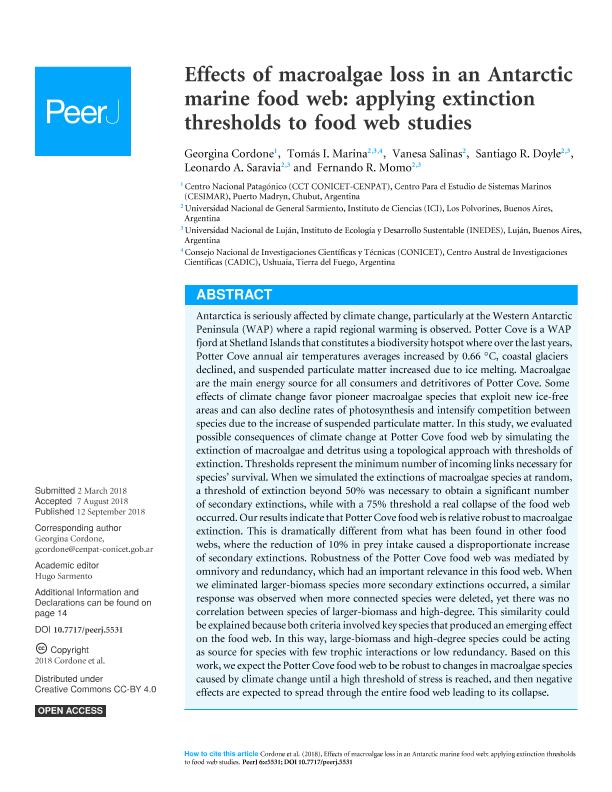Mostrar el registro sencillo del ítem
dc.contributor.author
Cordone, Georgina Florencia

dc.contributor.author
Marina, Tomas Ignacio

dc.contributor.author
Salinas, Vanesa Anabella

dc.contributor.author
Doyle, Santiago Raúl

dc.contributor.author
Saravia, Leonardo Ariel

dc.contributor.author
Momo, Fernando Roberto

dc.date.available
2020-05-05T20:15:09Z
dc.date.issued
2018-09
dc.identifier.citation
Cordone, Georgina Florencia; Marina, Tomas Ignacio; Salinas, Vanesa Anabella; Doyle, Santiago Raúl; Saravia, Leonardo Ariel; et al.; Effects of macroalgae loss in an Antarctic marine food web: applying extinction thresholds to food web studies; PeerJ; PeerJ; 6; 9-2018; 1-20
dc.identifier.issn
2167-8359
dc.identifier.uri
http://hdl.handle.net/11336/104289
dc.description.abstract
Antarctica is seriously affected by climate change, particularly at the Western Antarctic Peninsula (WAP) where a rapid regional warming is observed. Potter Cove is a WAP fjord at Shetland Islands that constitutes a biodiversity hotspot where over the last years, Potter Cove annual air temperatures averages increased by 0.66◦C, coastal glaciers declined, and suspended particulate matter increased due to ice melting. Macroalgae are the main energy source for all consumers and detritivores of Potter Cove. Some effects of climate change favor pioneer macroalgae species that exploit new ice-free areas and can also decline rates of photosynthesis and intensify competition between species due to the increase of suspended particulate matter. In this study, we evaluated possible consequences of climate change at Potter Cove food web by simulating the extinction of macroalgae and detritus using a topological approach with thresholds of extinction. Thresholds represent the minimum number of incoming links necessary for species? survival. When we simulated the extinctions of macroalgae species at random, a threshold of extinction beyond 50% was necessary to obtain a significant number of secondary extinctions, while with a 75% threshold a real collapse of the food web occurred. Our results indicate that Potter Cove food web is relative robust to macroalgae extinction. This is dramatically different from what has been found in other food webs, where the reduction of 10% in prey intake caused a disproportionate increase of secondary extinctions. Robustness of the Potter Cove food web was mediated by omnivory and redundancy, which had an important relevance in this food web. When we eliminated larger-biomass species more secondary extinctions occurred, a similarresponse was observed when more connected species were deleted, yet there was nocorrelation between species of larger-biomass and high-degree. This similarity could be explained because both criteria involved key species that produced an emerging effect on the food web. In this way, large-biomass and high-degree species could be acting as source for species with few trophic interactions or low redundancy. Based on this work, we expect the Potter Cove food web to be robust to changes in macroalgae species caused by climate change until a high threshold of stress is reached, and then negative effects are expected to spread through the entire food web leading to its collapse.
dc.format
application/pdf
dc.language.iso
eng
dc.publisher
PeerJ
dc.rights
info:eu-repo/semantics/openAccess
dc.rights.uri
https://creativecommons.org/licenses/by/2.5/ar/
dc.subject
ANTARCTIC
dc.subject
FOOD WEBS
dc.subject
EXTINCTIONS
dc.subject
MACROALGAE LOSS
dc.subject.classification
Ecología

dc.subject.classification
Ciencias Biológicas

dc.subject.classification
CIENCIAS NATURALES Y EXACTAS

dc.title
Effects of macroalgae loss in an Antarctic marine food web: applying extinction thresholds to food web studies
dc.type
info:eu-repo/semantics/article
dc.type
info:ar-repo/semantics/artículo
dc.type
info:eu-repo/semantics/publishedVersion
dc.date.updated
2020-04-24T17:55:32Z
dc.journal.volume
6
dc.journal.pagination
1-20
dc.journal.pais
Estados Unidos

dc.journal.ciudad
San Diego
dc.description.fil
Fil: Cordone, Georgina Florencia. Consejo Nacional de Investigaciones Científicas y Técnicas. Centro Científico Tecnológico Conicet - Centro Nacional Patagónico. Centro para el Estudio de Sistemas Marinos; Argentina
dc.description.fil
Fil: Marina, Tomas Ignacio. Consejo Nacional de Investigaciones Científicas y Técnicas. Centro Austral de Investigaciones Científicas; Argentina. Universidad Nacional de Luján. Instituto de Ecología y Desarrollo Sustentable. Consejo Nacional de Investigaciones Científicas y Técnicas. Oficina de Coordinación Administrativa Parque Centenario. Instituto de Ecología y Desarrollo Sustentable; Argentina. Universidad Nacional de General Sarmiento. Instituto de Ciencias; Argentina
dc.description.fil
Fil: Salinas, Vanesa Anabella. Consejo Nacional de Investigaciones Científicas y Técnicas; Argentina. Universidad Nacional de General Sarmiento. Instituto de Ciencias; Argentina
dc.description.fil
Fil: Doyle, Santiago Raúl. Universidad Nacional de General Sarmiento. Instituto de Ciencias; Argentina. Universidad Nacional de Luján. Instituto de Ecología y Desarrollo Sustentable. Consejo Nacional de Investigaciones Científicas y Técnicas. Oficina de Coordinación Administrativa Parque Centenario. Instituto de Ecología y Desarrollo Sustentable; Argentina
dc.description.fil
Fil: Saravia, Leonardo Ariel. Universidad Nacional de Luján. Instituto de Ecología y Desarrollo Sustentable. Consejo Nacional de Investigaciones Científicas y Técnicas. Oficina de Coordinación Administrativa Parque Centenario. Instituto de Ecología y Desarrollo Sustentable; Argentina. Universidad Nacional de General Sarmiento. Instituto de Ciencias; Argentina
dc.description.fil
Fil: Momo, Fernando Roberto. Universidad Nacional de Luján. Instituto de Ecología y Desarrollo Sustentable. Consejo Nacional de Investigaciones Científicas y Técnicas. Oficina de Coordinación Administrativa Parque Centenario. Instituto de Ecología y Desarrollo Sustentable; Argentina. Universidad Nacional de General Sarmiento. Instituto de Ciencias; Argentina
dc.journal.title
PeerJ
dc.relation.alternativeid
info:eu-repo/semantics/altIdentifier/doi/http://dx.doi.org/10.7717/peerj.5531
dc.relation.alternativeid
info:eu-repo/semantics/altIdentifier/url/https://peerj.com/articles/5531/
Archivos asociados
